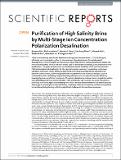| dc.contributor.author | Kwak, Rhokyun | |
| dc.contributor.author | Kwon, Hyukjin J. | |
| dc.contributor.author | Al-Anzi, Bader | |
| dc.contributor.author | Lim, Geunbae | |
| dc.contributor.author | Kim, Bumjoo | |
| dc.contributor.author | Pham, Van-Sang | |
| dc.contributor.author | Kim, Minseok | |
| dc.contributor.author | Han, Jongyoon | |
| dc.date.accessioned | 2017-04-12T19:40:37Z | |
| dc.date.available | 2017-04-12T19:40:37Z | |
| dc.date.issued | 2016-08 | |
| dc.date.submitted | 2016-01 | |
| dc.identifier.issn | 2045-2322 | |
| dc.identifier.uri | http://hdl.handle.net/1721.1/108083 | |
| dc.description.abstract | There is an increasing need for the desalination of high concentration brine (>TDS 35,000 ppm) efficiently and economically, either for the treatment of produced water from shale gas/oil development, or minimizing the environmental impact of brine from existing desalination plants. Yet, reverse osmosis (RO), which is the most widely used for desalination currently, is not practical for brine desalination. This paper demonstrates technical and economic feasibility of ICP (Ion Concentration Polarization) electrical desalination for the high saline water treatment, by adopting multi-stage operation with better energy efficiency. Optimized multi-staging configurations, dependent on the brine salinity values, can be designed based on experimental and numerical analysis. Such an optimization aims at achieving not just the energy efficiency but also (membrane) area efficiency, lowering the true cost of brine treatment. ICP electrical desalination is shown here to treat brine salinity up to 100,000 ppm of Total Dissolved Solids (TDS) with flexible salt rejection rate up to 70% which is promising in a various application treating brine waste. We also demonstrate that ICP desalination has advantage of removing both salts and diverse suspended solids simultaneously, and less susceptibility to membrane fouling/scaling, which is a significant challenge in the membrane processes. | en_US |
| dc.language.iso | en_US | |
| dc.publisher | Nature Publishing Group | en_US |
| dc.relation.isversionof | http://dx.doi.org/10.1038/srep31850 | en_US |
| dc.rights | Creative Commons Attribution 4.0 International License | en_US |
| dc.rights.uri | http://creativecommons.org/licenses/by/4.0/ | en_US |
| dc.source | Nature | en_US |
| dc.title | Purification of High Salinity Brine by Multi-Stage Ion Concentration Polarization Desalination | en_US |
| dc.type | Article | en_US |
| dc.identifier.citation | Kim, Bumjoo; Kwak, Rhokyun; Kwon, Hyukjin J.; Pham, Van Sang; Kim, Minseok; Al-Anzi, Bader; Lim, Geunbae and Han, Jongyoon. “Purification of High Salinity Brine by Multi-Stage Ion Concentration Polarization Desalination.” Scientific Reports 6 (August 22, 2016): 31850. © Authors 2016 | en_US |
| dc.contributor.department | Massachusetts Institute of Technology. Department of Electrical Engineering and Computer Science | en_US |
| dc.contributor.department | Massachusetts Institute of Technology. Research Laboratory of Electronics | en_US |
| dc.contributor.mitauthor | Kim, Bumjoo | |
| dc.contributor.mitauthor | Pham, Van-Sang | |
| dc.contributor.mitauthor | Kim, Minseok | |
| dc.contributor.mitauthor | Han, Jongyoon | |
| dc.relation.journal | Scientific Reports | en_US |
| dc.eprint.version | Final published version | en_US |
| dc.type.uri | http://purl.org/eprint/type/JournalArticle | en_US |
| eprint.status | http://purl.org/eprint/status/PeerReviewed | en_US |
| dspace.orderedauthors | Kim, Bumjoo; Kwak, Rhokyun; Kwon, Hyukjin J.; Pham, Van Sang; Kim, Minseok; Al-Anzi, Bader; Lim, Geunbae; Han, Jongyoon | en_US |
| dspace.embargo.terms | N | en_US |
| dc.identifier.orcid | https://orcid.org/0000-0003-2955-793X | |
| dc.identifier.orcid | https://orcid.org/0000-0001-7215-1439 | |
| mit.license | PUBLISHER_CC | en_US |
